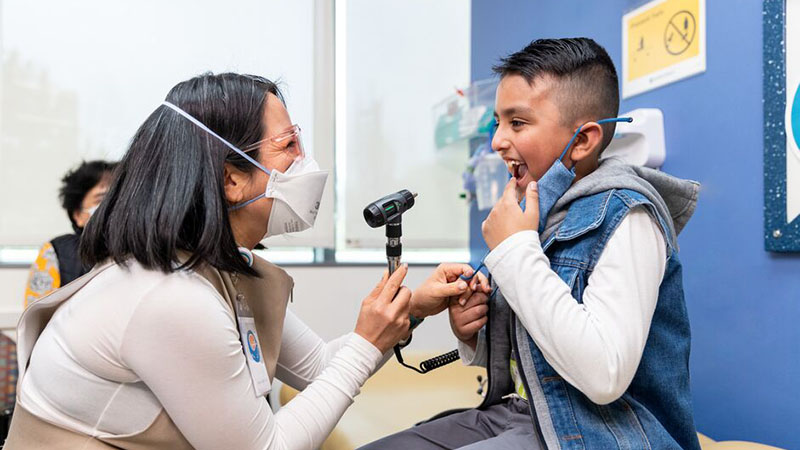Liver Failure
What is liver failure?
Liver failure means the liver cannot perform its vital functions in the body, such as producing chemicals and filtering blood.
-
Are there different types of liver failure?
There are two common types of liver failure:
- When liver failure results from a sudden illness in a person with no history of liver disease, it is called acute or fulminant liver failure.
- When liver failure occurs at the end of a long-standing liver disease, it is called chronic liver failure or end-stage liver disease. Chronic liver failure is linked to severe scarring of the liver, which is called cirrhosis.
-
What causes cirrhosis in children?
Another liver condition, biliary atresia, is the leading cause of cirrhosis in children. Biliary atresia happens when children are born without bile ducts or with abnormal bile ducts. Biliary atresia is the reason for about half of all liver transplants among children.
-
How serious is liver failure?
If your child has liver failure, their liver might not get better. They might need a liver transplant for long-term survival.
-
Who gets liver disease?
Liver disease affects people of all ages. There are more than 100 known liver diseases. Serious liver disease affects about 1 in every 2,500 children in the United States.
Gastroenterology and Hepatology at Seattle Children's
Symptoms of Liver Failure
Liver failure can happen as the result of many types of problems with the liver. It can come on suddenly — for example, after poisoning with certain chemicals, herbs or even some medicines. It can be the result of a longer-term disease or defect, such as hepatitis or biliary atresia. Symptoms of all these problems vary.
-
Jaundice
One of the first signs of a problem with your child’s liver is jaundice. Jaundice happens when the liver is unable to remove bilirubin, a yellow pigment, from the blood. This gives a yellow color to a child’s skin and the whites of the eyes.
Many healthy babies have mild jaundice, especially during the first week or two of life. This normal type of jaundice usually goes away by the time your child is about 2 weeks old. If jaundice gets worse, take your baby to the doctor to check for a possible liver problem.
Other symptoms of jaundice are:
- Darkening in the color of urine
- Pale, grey or white bowel movements (stools)
-
Other symptoms of liver disease or liver failure
Your child might also have these symptoms:
- Bruising or bleeding easily
- Weakness
- Extreme tiredness (fatigue)
- Loss of appetite
- Nausea
- Trouble thinking
- Swelling or bloating in the belly area (abdomen)
- Generally feeling ill
Diagnosing Liver Failure
Your child’s doctor may suspect liver failure after:
- Asking you about your child’s symptoms
- Examining your child
Your child will also have blood tests so the doctor can see how well their liver is working.
Treating Liver Failure
Some liver diseases can be treated with medicines. Sometimes, these medicines treat the symptoms of the disease but do not cure it. If your child’s liver is not failing, that may be all the treatment they need.
If your child’s liver condition continues to worsen over time, doctors may give medicines to help their liver work as well as it can for as long as it can. Sometimes children take these medicines to delay the need for a liver transplant or to wait until a liver is available for transplant.
If your child’s condition advances to liver failure, treatment may be a liver transplant. Learn more about our Liver Transplant Program at Seattle Children’s and what to expect if your child needs a liver transplant.
Liver Failure at Seattle Children’s
Seattle Children’s has been treating children with liver diseases and performing liver transplant surgery since 1990. We have the only liver transplant program in the Pacific Northwest that cares exclusively for children and teens. We perform:
- Deceased-donor liver transplants
- Living-donor liver transplants
- Split-liver transplants
- Reduced-size liver transplants
- ABO-incompatible liver transplants
-
We are committed to excellent results
Overall survival rates for children who receive liver transplants at Seattle Children’s are excellent. We are committed to family-centered care to ensure the best results, both for our patients and in terms of organ survival. We are constantly improving surgery techniques and medication therapy strategies to provide the most current treatments and the very best care for your child.
-
The experts you need are here
Our team includes nationally and internationally known experts in children’s liver diseases.
- Dr. Patrick Healey, Seattle Children’s division chief of Transplantation, is one of the few doctors with formal training and expertise in both pediatric surgery and transplant surgery. He has performed more than 200 liver transplantations (as well as 300 kidney transplantations) on children.
- Dr. Evelyn Hsu, medical director of Liver and Intestine Transplant, is an accomplished and well recognized specialist and transplant doctor.
We are committed to recruiting and retaining the best transplant providers.
-
A whole team cares for your child
Our medical and surgical specialists, working together, consider your child’s unique needs to evaluate their condition and develop a treatment plan. Many other pediatric transplant experts, like advanced registered nurse practitioners, pharmacists and dietitians, take part in your child’s treatment. Our team-based approach ensures that your child gets the very best care.
-
Research to improve care
We continue to advance the practice and understanding of transplants through our research programs. Our top research priority is finding ways to make children who have transplants less dependent on antirejection drugs.
Learn more about our liver transplant research and clinical studies.
Contact Us
Contact Seattle Children’s Gastroenterology and Hepatology Department at 206-987-2521 for a referral, a second opinion or more information.
Providers, see how to refer a patient.


